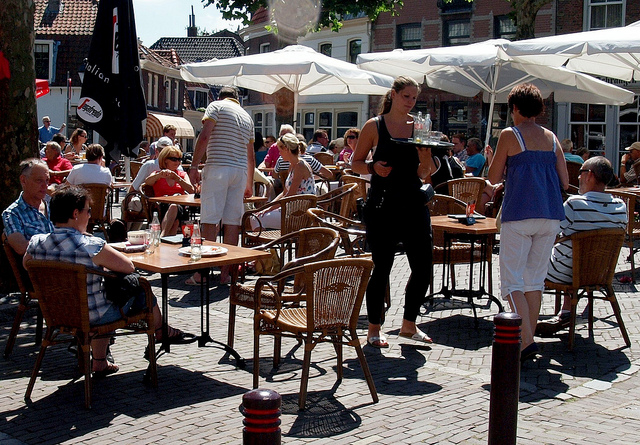
You may have come across that crazy Craigslist story about an NYC restaurant using tapes from 2004 and 2014 to show how cell phones were causing the establishment to garner bad reviews.
The story sets off major *fake* alarms. Let’s touch upon a few things that make us go “hrrrm”:
- Original post = anonymous, (now) deleted, not substantiated
- Magically old tapes show up for the exact type of day, time, & season for comparison
- If cell phones = bad reviews, every restaurant on Earth gets bad reviews ??? (No)
- The staff never once checked their own phones?
- 3 minutes to shoot a pic of food = extremely slow Instagrammer
- Wait staff taking pics of diners = less than 1 minute
- Sour-grapey tone against customers not realistic (biz ppl <3 customers!)
- The urban legend likeliness level = 100%
There are more iffy bits to pick apart but let’s talk about the urban-legendness of the story. Any perfectly-plotted viral digital rumor should ring warning bells.

Wikipedia Urban Legend: Many urban legends are framed as complete stories with plot and characters. The compelling appeal of a typical urban legend is its elements of mystery, horror, fear or humor. Often they serve as cautionary tales. Some urban legends are morality tales that depict someone, usually a child, acting in a disagreeable manner, only to wind up in trouble, hurt, or dead.
Like many urban legends before it, the Craigslist Restaurant story zeroes in on one of our biggest and most visceral fears. In this case, the fear of technology changing and perhaps irrevocably damaging our society.
Psychologists and sociologists study the lifecycle of technology adoption. They look at the behaviors and interactions of various groups on a spectrum of innovators, early adopters, late adopters, to technophobes. When we decide to integrate new tech into our lives, we go through a common workflow, depending on where we are on that technology-adoption spectrum.
The individual’s process of tech adoption generally adheres to a certain cycle within that spectrum. Sometimes tech adoption is seamless. Other tech radically disrupts a person’s habits. Here’s a quick and simplified look at a normal “Individual Disruption Cycle,” or individual’s interaction with disruptive technology.
Stage One: “What the H-E-Double-Hockey-Sticks is that thing?”
A new device or service is adopted by one’s peers widely and quickly.
Stage Two: “Get it the H-E-Double-Hockey-Sticks away from me.”
A knee-jerk reaction of discomfort is the initial impression.
Stage Three: “I hate those H-E-Double-Hockey-Stickish things!”
The individual, unsure or embarrassed by her initial reaction, searches for evidence to justify her knee-jerk discomfort. She will ignore any evidence that paints the new technology in a positive light.
Sometimes there’s a Stage 4.
Stage Four: “I don’t know what the H-E-Double-Hockey-Sticks I was thinking. I love my new thing!”
The individual adapts to the changing environment and adopts the tech.
Disruptive tech is annoying and sometimes scary. We cannot help but first react emotionally and physiologically to a strange stimuli. When our higher order thinking catches up, we retroactively match up our current thinking to our initial reaction. When we succeed in justifying our knee-jerk instinct, we will feel safety and satisfaction. Because of this square-peg-meets-square-hole feeling, we’ll go to great lengths to ensure the first impression is the lasting impression, even when overwhelming evidence dictates our first impression was false.
Our culture is currently in this justification mode when it comes to the ubiquity of cell phones. We’ve all felt the seismic shift of Internet connectivity over the past 2 decades. Mobile phone use spread at quicker rates than home Internet service. Sociologically and psychologically, we’re having a harder time catching up. The Craigslist Restaurant Story is “comforting” folklore in that it gives credence to our fears that cell phones are making life worse for everyone.
What to do with it when friends post these kinds of urban legends about tech? Take it in stride. They’re processing their ever-changing environment. It may help to share more “Yay! Tech!” stories, like how tech saved a life or how it’s helping educate underserved populations. The opposite of fear is education. Spread a little knowledge …
and maybe put down your cell phone at dinner. 😉
______
Photo credits: Zoetnet on Flickr (terrace scene)
Poster: Photo by Jen Diaz-Infante on Flickr, modified by PurpleCar with Wikipedia quote
